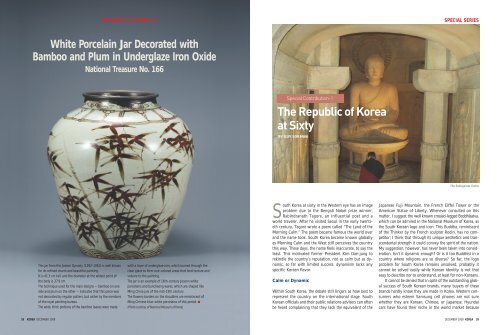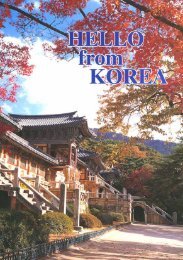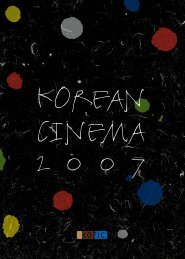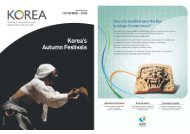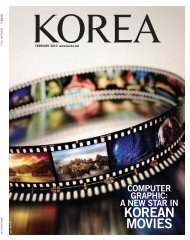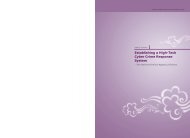Seoul Lights Up for the Holiday Season - Korea.net
Seoul Lights Up for the Holiday Season - Korea.net
Seoul Lights Up for the Holiday Season - Korea.net
You also want an ePaper? Increase the reach of your titles
YUMPU automatically turns print PDFs into web optimized ePapers that Google loves.
THE BEAUTY OF KOREA-17<br />
SPECIAL SERIES<br />
White Porcelain Jar Decorated with<br />
Bamboo and Plum in Underglaze Iron Oxide<br />
National Treasure No. 166<br />
Special Contribution-1<br />
The Republic of <strong>Korea</strong><br />
at Sixty<br />
BY GUY SORMAN<br />
The Seokguram Grotto<br />
This jar from <strong>the</strong> Joseon Dynasty (1392-1910) is well known<br />
<strong>for</strong> its refined charm and beautiful painting.<br />
It is 41.3 cm tall, and <strong>the</strong> diameter at <strong>the</strong> widest point of<br />
<strong>the</strong> body is 37.9 cm.<br />
The technique used <strong>for</strong> <strong>the</strong> main designs — bamboo on one<br />
side and plum on <strong>the</strong> o<strong>the</strong>r — indicates that this piece was<br />
not decorated by regular potters, but ra<strong>the</strong>r by <strong>the</strong> members<br />
of <strong>the</strong> royal painting bureau.<br />
The wide, thick portions of <strong>the</strong> bamboo leaves were made<br />
with a layer of underglaze iron, which burned through <strong>the</strong><br />
clear glaze to <strong>for</strong>m rust-colored areas that lend texture and<br />
volume to <strong>the</strong> painting.<br />
The jar is an example of 16th-century Joseon white<br />
porcelains and buncheong wares, which are shaped like<br />
Ming China jars of <strong>the</strong> mid-15th century.<br />
The flowery borders on <strong>the</strong> shoulders are reminiscent of<br />
Ming Chinese blue-white porcelains of this period. ■<br />
(Photo courtesy of National Museum of <strong>Korea</strong>)<br />
South <strong>Korea</strong> at sixty in <strong>the</strong> Western eye has an image<br />
problem due to <strong>the</strong> Bengali Nobel prize winner,<br />
Rabindranath Tagore, an influential poet and a<br />
world traveler. After he visited <strong>Seoul</strong> in <strong>the</strong> early twentieth<br />
century, Tagore wrote a poem called “The Land of <strong>the</strong><br />
Morning Calm.” The poem became famous <strong>the</strong> world over<br />
and <strong>the</strong> name took. South <strong>Korea</strong> became known globally<br />
as Morning Calm and <strong>the</strong> West still perceives <strong>the</strong> country<br />
this way. These days, <strong>the</strong> name feels inaccurate, to say <strong>the</strong><br />
least. This motivated <strong>for</strong>mer President Kim Dae-jung to<br />
rekindle <strong>the</strong> country’s reputation, not as calm but as dynamic,<br />
so far with limited success: dynamism lacks any<br />
specific <strong>Korea</strong>n flavor.<br />
Calm or Dynamic<br />
Within South <strong>Korea</strong>, <strong>the</strong> debate still lingers as how best to<br />
represent <strong>the</strong> country on <strong>the</strong> international stage. South<br />
<strong>Korea</strong>n officials and <strong>the</strong>ir public relations advisers can often<br />
be heard complaining that <strong>the</strong>y lack <strong>the</strong> equivalent of <strong>the</strong><br />
Japanese Fuji Mountain, <strong>the</strong> French Eiffel Tower or <strong>the</strong><br />
American Statue of Liberty. Whenever consulted on this<br />
matter, I suggest <strong>the</strong> well known crossed-legged Boddhisatva,<br />
which can be admired in <strong>the</strong> National Museum of <strong>Korea</strong>, as<br />
<strong>the</strong> South <strong>Korea</strong>n logo and icon. This Buddha, reminiscent<br />
of <strong>the</strong> Thinker by <strong>the</strong> French sculptor Rodin, has no competitor;<br />
I think that through its unique aes<strong>the</strong>tics and transcendental<br />
strength it could convey <strong>the</strong> spirit of <strong>the</strong> nation.<br />
My suggestion, however, has never been taken into consideration.<br />
Isn’t it dynamic enough? Or is it too Buddhist in a<br />
country where religions are so diverse? So far, <strong>the</strong> logo<br />
problem <strong>for</strong> South <strong>Korea</strong> remains unsolved; probably it<br />
cannot be solved easily while <strong>Korea</strong>n identity is not that<br />
easy to describe nor to understand, at least <strong>for</strong> non-<strong>Korea</strong>ns.<br />
It cannot be denied that in spite of <strong>the</strong> outstanding global<br />
success of South <strong>Korea</strong>n brands, many buyers of <strong>the</strong>se<br />
brands hardly know <strong>the</strong>y are made in <strong>Korea</strong>. Western consumers<br />
who esteem Samsung cell phones are not sure<br />
whe<strong>the</strong>r <strong>the</strong>y are <strong>Korea</strong>n, Chinese, or Japanese. Hyundai<br />
cars have found <strong>the</strong>ir niche in <strong>the</strong> world market because<br />
58 KOREA DECEMBER 2008<br />
DECEMBER 2008 KOREA 59


